September (Bhadrapad-Aashwin)
Sankashta Chaturthi (Bha.)
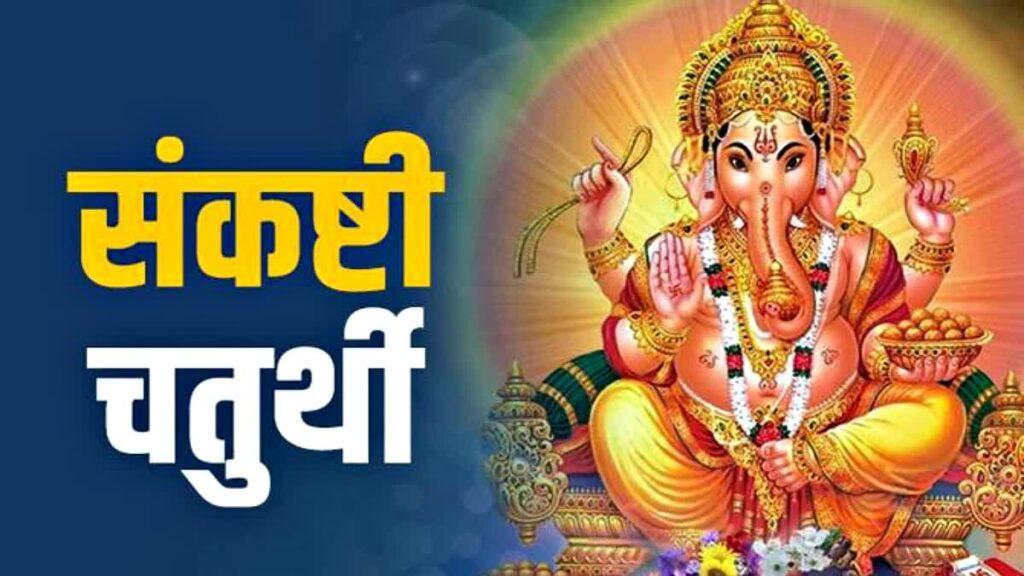
The word ‘Sankashti’ has a Sanskrit origin that means ‘deliverance during difficult times’ whereas ‘Chaturthi’ means ‘fourth day or the day of Lord Ganesha’..
Sankashti Chaturthi is celebrated in the month of Bhadrapada of Hindu calendar on the fourth day of Krishna Paksha (dark lunar phase or the waning phase).
Lord Ganesha symbolizes the remover of all obstacles and supreme lord of intelligence. Sankashti Chaturthi is an auspicious day dedicated to Lord Ganesha. If Sankashti Chaturthi falls on a Tuesday it is called Angarki Sankashti Chaturthi. Angarki Sankashti Chaturthi is considered highly auspicious among all the days of Sankashti Chaturthi festival. The Angarki Chaturthi where (angarak in Sanskrit means red like burning coal ambers). Devotees believe that their wishes can be fulfilled if they pray on this auspicious day.
On the Chaturthi day (4th day after full moon) of each month, the ‘Sankashti Ganapathi Pooja’ prayer is performed.).It is believed that the Vrat observed on this day can eradicate all the obstacles from the native’s life in order to live a happy and peaceful life ahead.
Janmashtami
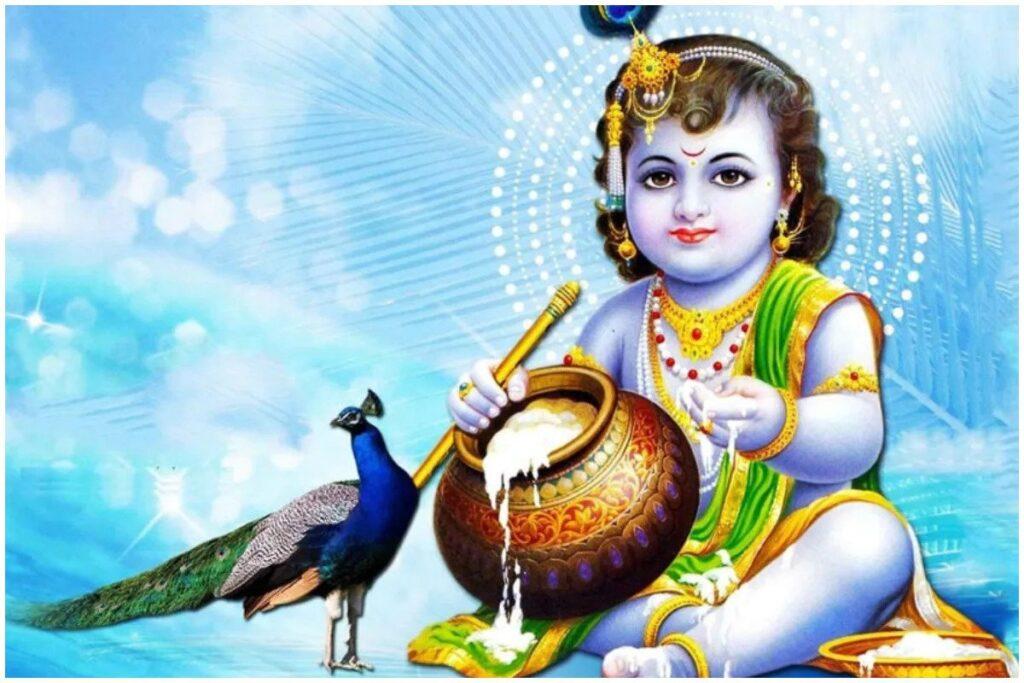
The Hindu festival Krishna Janmashtami or Shree Krishna Jayanti is also known by the name of Gokul Ashtami is celebrated with vigor around the world every year! This festival is considered as the birthday of Lord Krishna that falls on the eighth day of the Bhadrapada month (August-September).Krishna Janmashtami 2022 festival is considered as the birthday of Lord Krishna that falls on the eighth day of the Bhadrapada month (August- September).
The importance of Rituals Janmashtami is to encourage goodwill and to eradicate all the negativity from the world. The Janmashtami festival is the day when Lord Krishna made his earthly appearance. The poetry in the Bhagavadgita (a sacred book narrated by Lord Vishnu) say, that whenever there will be a predominance of evil and decline of religion. People celebrate this festival by fasting, singing, praying and visiting the temples.
Krishna Janmashtami is an auspicious celebration of the Hindu deity Krishna, the eighth Avatar of Vishnu. Sri Krishna is considered as one of the most influential human incarnations of the Lord Vishnu. He was born 5,241 years ago in Mathura i.e., on 21st July 3228 BC. The sole objective of Sri Krishna’s birth was to free the Earth from the evilness of demons. He played an important role in Mahabharata and propagated the theory of bhakti and good karma which is already narrated deeply in the Bhagwat Geeta..
This festival is celebrated on Bhadrapad Krishna Ashtami falling at midnight. If this Ashtami falls on two days and remains available during midnight then it is celebrated on the second day. If Ashtami falls at midnight on both days but Rohini Nakshatra falls on first then it should be celebrated on the first day otherwise on the second day..
Krishna Janmashtami is also celebrated in Nepal, Bangladesh, and Pakistan ,In South India, this festival is celebrated with fruits, ‘prasadam’ and devotional songs. Whereas, Maharashtra celebrates the festival by breaking of ‘Dahi handi’. The Janmashtami celebration of Mathura and Vrindavan, the places where Sri Krishna had spent his whole life, are very special. On this day temples and homes are wonderfully decorated and illuminated. Hindus celebrate Krishna Janmashtami by fasting and staying up until midnight. At midnight, devotees gather around for exchanging gifts, and sing devotional songs, dance, pujas, Aarti, the blowing of the Conch. Some temples also conduct readings of the Hindu religious scripture Bhagavadgita.
After chanting the Shlokas of Bhagavadgita the devotees of Lord Krishna recite following mantra for getting the blessings on the auspicious occasion of Janmashtami- “Om Namo Bhagvatey Vasudevaay”
This fast is observed on the Ashtami of the dark moon of Bhadrapada.This fast should be open only after midnight. One can open his/her fast with fried balls of Kuttu flour, sweets made of condensed milk, and Halwa made of water chestnut. In this fast, it is very auspicious to listen to Srikrishna Janmashtami Vrata Katha.
Haritalika Teeja
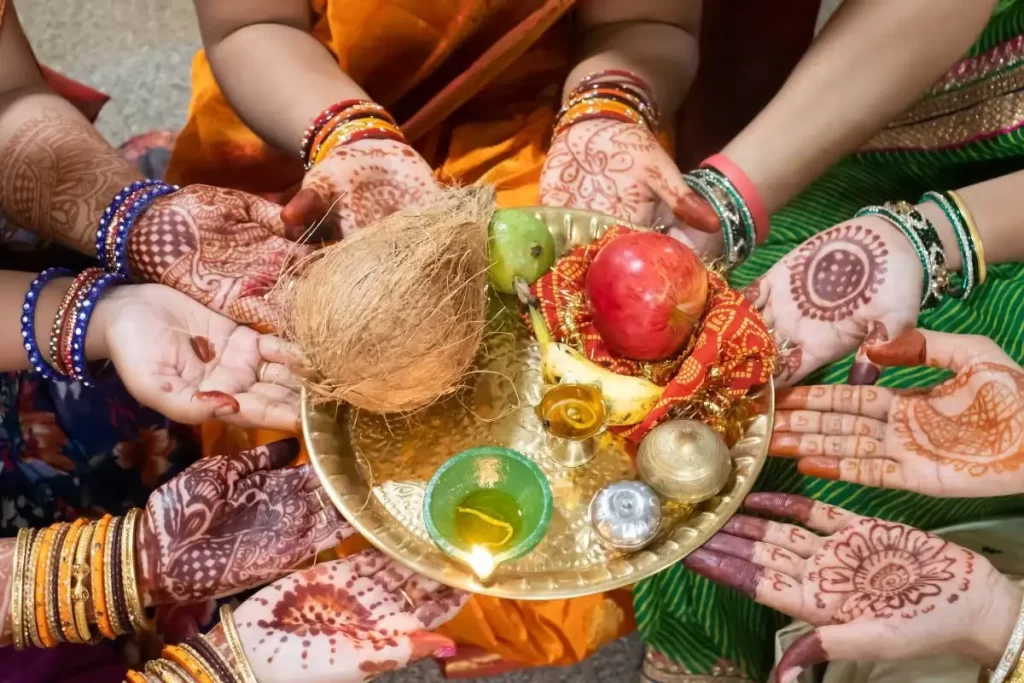
People celebrate this festival to get blessings of Maa Parvati to have a spouse like Shiva-Parvati. Mostly women celebrate this festival to get a husband like Lord Shiva and if they are already married then they pray for the long life of their husband.
According to the legend of Hartalika Teej, Goddess Parvati was incarnated as Goddess Shailaputri. A friend of Goddess Shailaputri took her to the thick forest so that her father would not marry her to Lord Vishnu against her wish. Eventually, Goddess Shailaputri was united with Lord Shiva.
The Hartalika Teej festival has also spread to parts of Madhya Pradesh where it is celebrated as a minor festival.Hartalika Teej of the north is not to be confused with Hartalika Teej of Maharashtra which is connected to the festival of Gowri Habba.
Ganesh Chaturthi
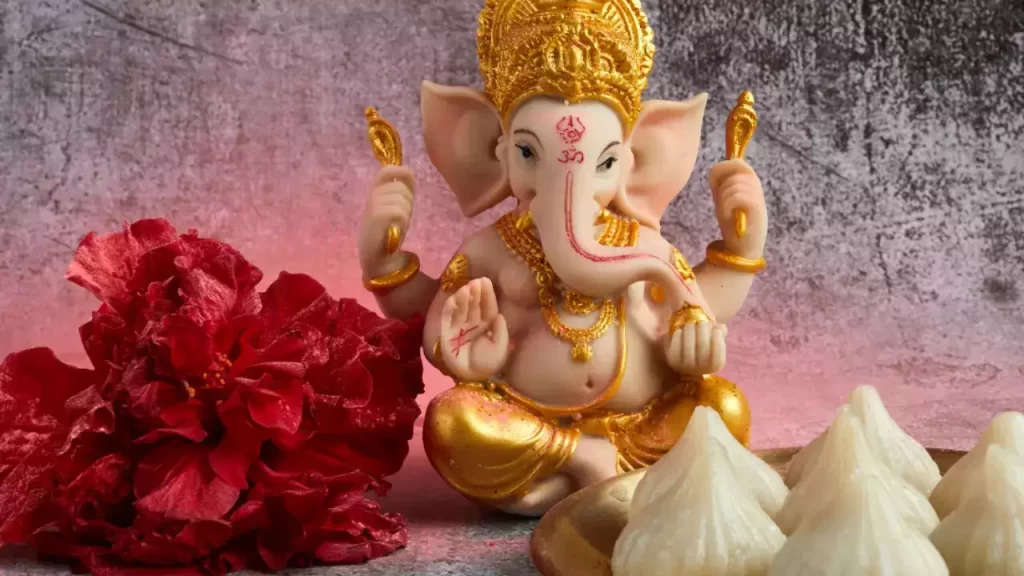
Ganesh Chaturthi is celebrated by Hindus around the world as the birthday of Lord Ganesh. This auspicious festival is celebrated in the most elaborate way in Maharashtra that lasts for 10 days here.
It is highly believed that Lord Ganesha bestows his presence on earth for all his devotees during the festival of Ganesha Chaturthi. Ganesh Utsav is celebrated every year in the Bhadrapada month according to the Hindu calendar of the fourth day that is a bright fortnight. The festival lasts for 10 days, ending on Anant Chaturthi 2019 (fourteenth day of the waxing moon period). Ganesha Chaturthi is considered as the birthday of Lord Ganesha.
Ganesh Chaturthi was being celebrated as an important public event in Pune since the times of Shivaji (1630–1680), the founder of the Maratha Empire. The Peshwas, the de facto hereditary administrators of the Empire from 1749 to 1818, encouraged the celebrations in their administrative seat Pune as Lord Ganesha was their family deity (Kuladevata). In 1893, the Lokmanya Tilak transformed this annual domestic festival into a large, well-organized public event. Tilak recognized the wide appeal of the deity Lord Ganesha as “the supreme god for everybody”, Tilak was the first to introduce large public images of Ganesh in pavilions, and also established the practice of submerging in rivers, sea.
This festival of Ganpati Sthapana is mainly celebrated in Maharashtra. It is celebrated on Bhadrapad Shukla Chaturthi falling during Madhyahana (mid-day). If on the first day Chaturthi falls on part of Madhyahana (mid-day)
On Narada’s suggestion, Krishna performed the fast of Ganesh Chaturthi (also known as Vinayagar Chaturthi) and got rid of the curse. Hence, the one who worships Lord Ganesha and fasts on this day gets rid of all the allegations.
By the last evening, the immersion of the idol in a water body is conducted on the last day of the festival. It is accompanied by a procession of people chanting bhajans and shlokas and songs.after some prayers, he should be carried to a sea or some water body for immersion.
Radhashtami
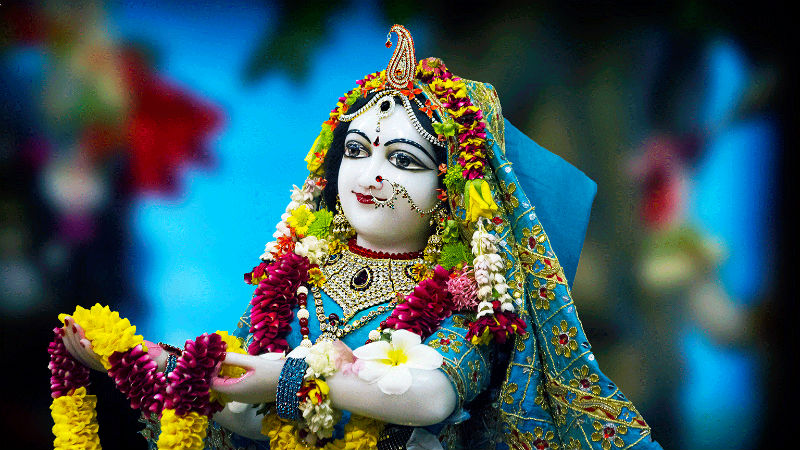
Radha Ashtami Festival celebrates the Birth Anniversary of “Shri Radha Rani”, the consort of “Lord Krishna”. It is celebrated on the Ashtami (8th day) of the Shukla Paksha during the month of Bhadrapada according to the Hindu Calendar. It is also known as “Radha Jayanti” Radha Ashtami is celebrated 15 days after the “Janmashtami”, the birth anniversary of Lord Krishna. This Hindu festival is even grandeur in Mathura, Vrindavan, the birthplace of Lord Krishna. In Sanskrit word, Radha means “Prosperity”. She is also known as “Jagat Janani”, mother of the universe.Radhashtami’ is a Hindu holy day commemorating the birth anniversary of Radha, the lover-consort of the god Krishna. Radhastami is celebrated by Krishna devotees as the appearance anniversary of Radharani, who is Krishna’s greatest devotee.
According to the traditions, when Lord Vishnu took ‘avatar’ like Krishna, Goddess Laxmi appeared as ‘Radharani’. This day marks the birth anniversary of Radharani. The legend says that Vrishbhanu was going by a riverside in ‘Barsana’ where he heard the crying of a baby. To his astonishment, a baby girl was floating in a lotus flower on the river. Since he and his wife Kamlavati did not have any child of their own, they adopted her happily and started taking care of her. Radha appeared on the earth exactly two weeks after Lord Krishna’s earth and did not open her majestic eyes till the time Krishna did not appear before him. This festival is celebrated on Bhadrapad Shukla Ashtami falling during Aprahan (the muhurat in the afternoon). If this Ashtami falls or does not fall on two days in that situation it shall be celebrated on the second day .
Some devotees observe this fast for full day & some even without water. On this day, devotees of Krishna ask Radha for her favor; in turn, acquire Krishna’s grace. Radhashtami is ceremoniously celebrated in the Brij area. On Radhashtami day, a new outfit is offered to Radharani and the temple is lavishly decorated with flowers and garlands. On Radhastami, Radha Krishna icons are traditionally dressed entirely in flowers. Additionally, Radhashtami is the only day on which devotees may receive the darshan of Radha’s feet. On all other days, they remain covered.
Anant Chaturdashi Vrat
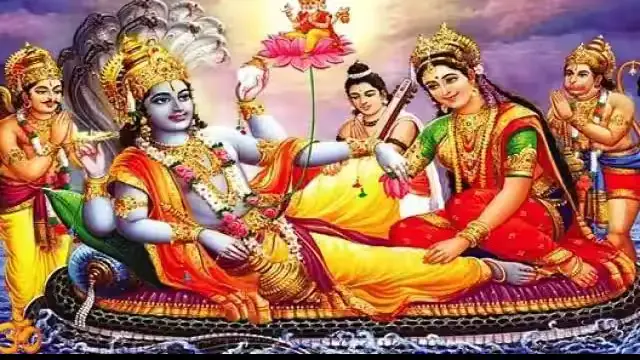
Anant Chaturdashi is usually celebrated on Bhadrapad Chaturdashi covering two muhurats. If this Chaturdashi falls or does not fall on two days then it is celebrated on the first day. It is generally the tenth or eleventh day after Ganesh Chaturthi,
On this day the Visarjan of idol of Lord Ganpati (Flowing of idol in holy waters) is done in Maharashtra. All the Ganesh idols brought into homes and communities are immersed in the sea or nearby lakes and rivers. On this day, people travel to the waterfront with the idols, large and small, dancing and singing in large processions. Lord Ganesha is departed, only to be welcomed the next year with equal excitement.
In parts of Bihar and Eastern UP, the festival is closely linked to kshirsagar (Ocean of Milk) and Lord Vishnu’s Anant Roopa. Fourteen tilaks(small vertical strips) of vermilion are made on a wooden plank. Fourteen puri(fried wheat bread) and fourteen pua(deep fried sweet wheat bread) are placed on these vermilion strips. A bowl containing Panchamrit (made of Milk, Curd, Jaggery, Honey and Ghee) symbolizing kshirsagar (Ocean of Milk) is placed on this wooden plank.A thread having fourteen knots, symbolizing Lord Anant is wrapped on a cucumber and is swirled five times in this “Ocean of Milk”. Later this Anant thread is tied on the right arm above the elbow by men. Women tie this on their left arm. This Anant thread is removed after fourteen days.
Shradh

The performance of Shraddha by a son during Pitru Paksha holds a great significance in Hindu Culture to ensure that their ancestors are resting in peace. In this context, the scripture Garuda Purana says, “there is no salvation for a man without a son”..
The performance of Sarva Pitru Amavasya rites can also compensate or neglected, which should ideally coincide with the death anniversary of the deceased. Shraddha involves offerings to three preceding generations- by reciting their names- as well as to the mythical lineage ancestor (gotra). A person thus gets to know the names of six generations (three preceding generations, his own and two succeeding generations—his sons and grandsons) in his life.
Pitru Paksha Shraddha (fortnight of the ancestors) is a 16–lunar day period when the Hindus pay homage to their ancestors (Pitras), especially through food offerings. This period is also known as Pitru Paksha, Pitru Dosha, Sola Shraddha (“sixteen shraddhas”), Kanagat, Jitiya, Mahalaya Paksha and Apara paksha.
Pitru Paksha is considered by Hindus to be inauspicious, it falls in the Hindu lunar month of Bhadrapada (September–October), beginning with the full moon day (Purnima) that occurs immediately after the Ganesh festival and ending with the new moon day known as Sarvapitri Amavasya, Pitru Amavasya, Peddala Amavasya, Mahalaya Amavasya or simply Mahalaya. In North India and Nepal, this period corresponds to the dark fortnight of the month Ashvin, instead of Bhadrapada..Shradh begins on Bhadrapad Purnima falling at Aparahna (after noon). If Purnima does not fall during Aparahna on both days then Shradh begin from first day.
The Shradha Ritual is performed on the specific lunar day during the Pitru Paksha when the ancestor—usually a parent or paternal grandparent—died. There are exceptions to the lunar day rule; special days are allotted for people who had died or had a certain status in life. Chautha Bharani and Bharani Panchami, the fourth and fifth lunar day respectively, are allocated for people deceased in the past year. Avidhava navami (“Widowed ninth”), the ninth lunar day, is for married women who died before their husbands. Widowers invite Brahmin women as guests for their wives’ shraddha. The twelfth lunar day is for children and ascetics who had renounced the worldly pleasures. The fourteenth day is known as Ghata chaturdashi or Ghayala chaturdashi, and is reserved for those people killed by arms, in war or suffered a violent death.
Sarva Pitru Amavasya (all fathers’ new moon day) is intended for all ancestors, irrespective of the lunar day they died. Those who have forgotten to perform shraddha can do so on this day. A Shradh Pitru Paksha 2019 ritual performed on this day is considered as fruitful as one conducted in the holy city of Gaya, which is seen as a special place to perform the rite, and hosts a fair during the Pitru Paksha period. In Bengal, Mahalaya marks the beginning of Durga Puja festivities. Mahalaya is the day when the goddess Durga is believed to have descended to Earth. Bengali people traditionally wake up early in the morning on Mahalaya to recite hymns from the Devi Mahatmyam (Chandi) scripture. Offerings to the ancestors are made in homes and at puja mandaps (temporary shrines). Matamaha (“Mother’s father”) or Dauhitra (“Daughter’s son”) also marks the first day of the month of Ashvin and the beginning of the bright fortnight. It is assigned to the grandson of the deceased maternal grandfather..
The ritual is also held on the death anniversary of the ancestor. The shraddha is performed only at noon, usually on the bank of a river or lake or at one’s own house. Families may also make a pilgrimage to places like Varanasi and Gaya to perform Shraddha. An annual Pitru Paksha Mela at Gaya on the banks of River Falgu. Pilgrims from all corners of the country visit Gaya for offering Pinda to their Ancestors. According to Bihar Tourism Department estimates, some 5,00,000 to 75,00,000 pilgrims arrive in the Gaya city during the Pitru Paksha Mela every year.
